-
Its consumption is widespread among those under 44 years of age (56%) and especially among those under 24: 70% listen to podcasts on a regular basis.
-
After two years of continuous growth, Spotify (30%) overtakes YouTube (29%) as the leading platform for searching and listening to podcasts, followed by iVoox (16%).
-
In the last year, 39% of podcast listeners have dedicated the same amount of time to it as in previous years and 28% say they have increased it.
-
According to the variable of vote recall in the 2019 general elections, voters of Unidas Podemos (50%) and those who abstained (48%) listen to more podcasts than those of other political options.
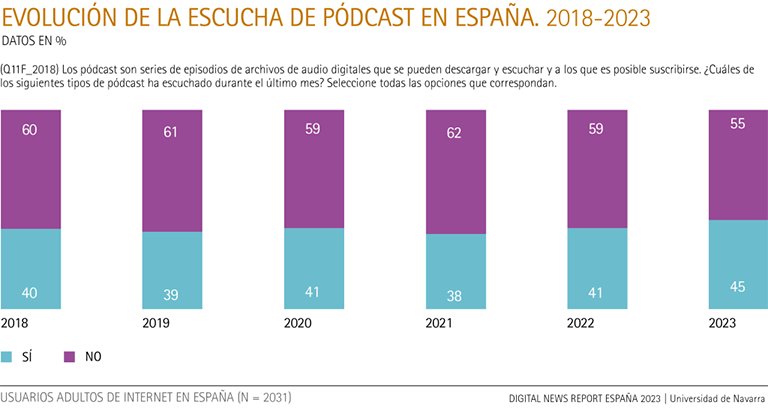
This is the highest percentage recorded since 2018. The proportion of listeners among respondents has remained stable over these six years. However, in 2023 (45%) it has grown by four percentage points compared to the previous year (41%).
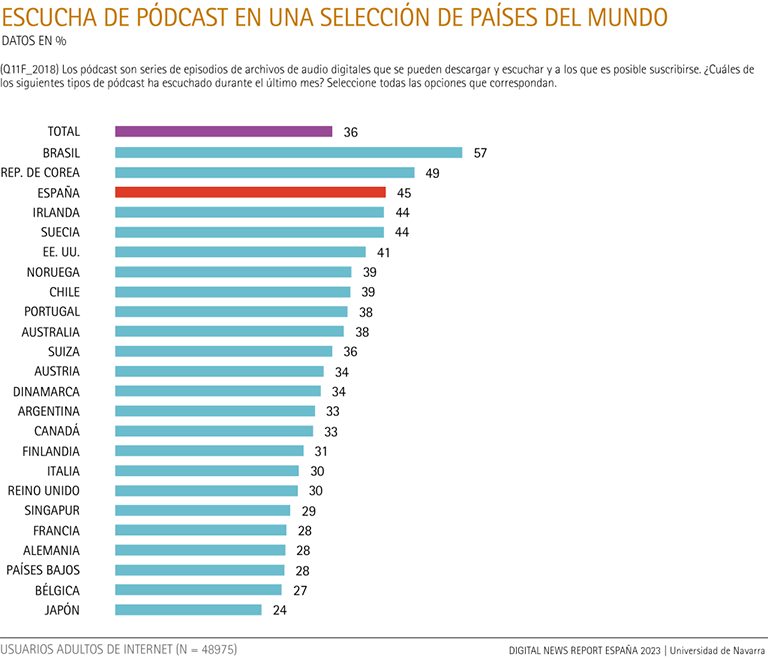
Spain is one of the countries where Internet users consume the most podcasts. This percentage is nine points higher than the average listening rate (36%) in all of the twenty-four countries in which survey asked about podcast consumption in 2023: Brazil (57%), Republic of Korea (49%), Spain (45%), Ireland (44%), Sweden (44%), United States (41%), Norway (39%), Chile (39%), Portugal (38%), Australia (38%), Switzerland (36%), Austria (34%), Denmark (34%), Argentina (33%), Canada (33%), Finland (31%), Italy (30%), United Kingdom (30%), Singapore (29%), France (28%), Germany (28%), Netherlands (28%), Belgium (27%) and Japan (24%).
As in other markets, in Spain men (51%) listen to more podcasts than women (38%). In all twenty-four countries surveyed, 40% of men and 32% of women report having listened to a podcast in the last month.
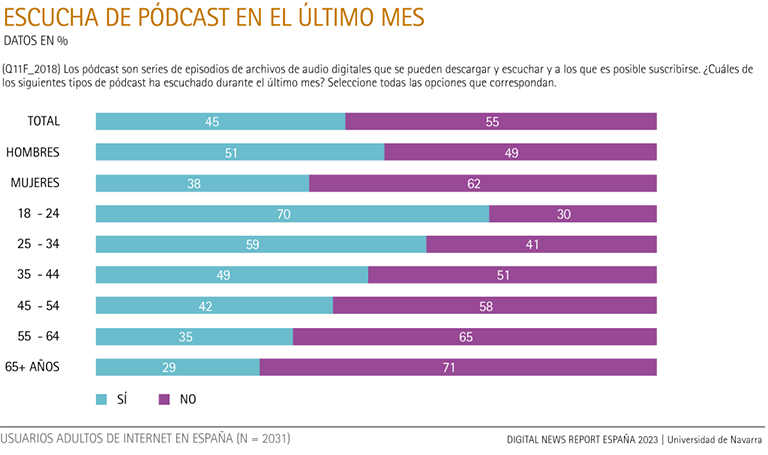
Seven out of ten 18-24 year-olds listen to podcasts
More than half of adult Internet users up to the age of 44 listen to some subject podcast (56%); the audience exceeds the proportion of six in ten among young people up to the age of 34 (61%), and reaches 70% among those aged 18 to 24. The social penetration of podcasting among the youngest has grown by fifteen percentage points since 2021 (55%). Conversely, interest in podcasting decreases with age. Despite this, three out of ten Internet users over the age of 55 say they listen to podcasts (33%).
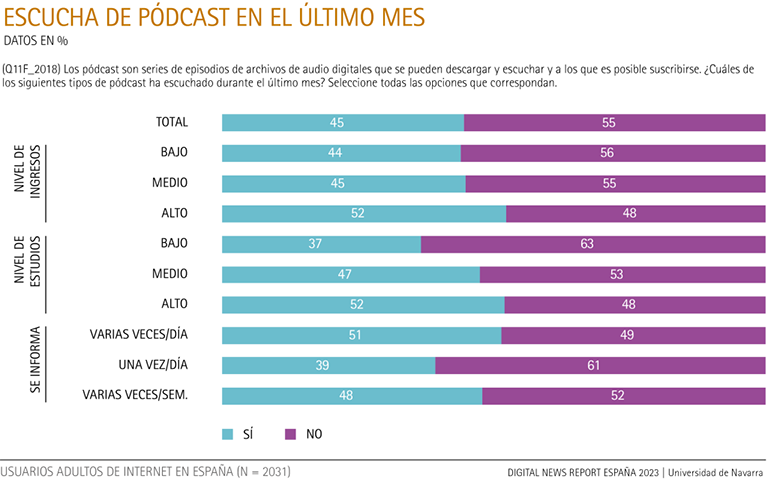
Five out of ten Internet users with a high level of educational listen to podcasts.
Income level, programs of study, frequency of enquiry of online news and interest in current affairs are variables that are related to podcast listening.
Thus, the podcast finds its main audience among Internet users with medium (47%) and high (52%) educational levels. The difference is significant compared to those with a low level of programs of study (37%). On the other hand, 63% of respondents with a low level of programs of study stated that they had not listened to a podcast in the last month; this is a significant difference compared to those who do not listen to podcasts with a medium (53%) and high (48%) level of educational .
The higher the income level of the Internet user, the higher the proportion of podcast listeners. The survey of 2023 sample shows a significant difference in favor of high-income Internet users: five out of ten (52%) listen to podcasts, compared to four out of ten at average (45%) and leave (44%).
In addition, a positive relationship is found between podcast listening and the frequency of enquiry of online news: they are half among those who access news several times a day (51%), and four out of ten among those who are informed once a day (39%); the difference is significant.
Likewise, the percentage of podcast listeners is higher, and the difference is significant, among those who are interested in the news (46%), compared to those who say they are not interested in current affairs (36%). The proportion is six out of ten (60%) among those who say they are extremely or very interested in the news.
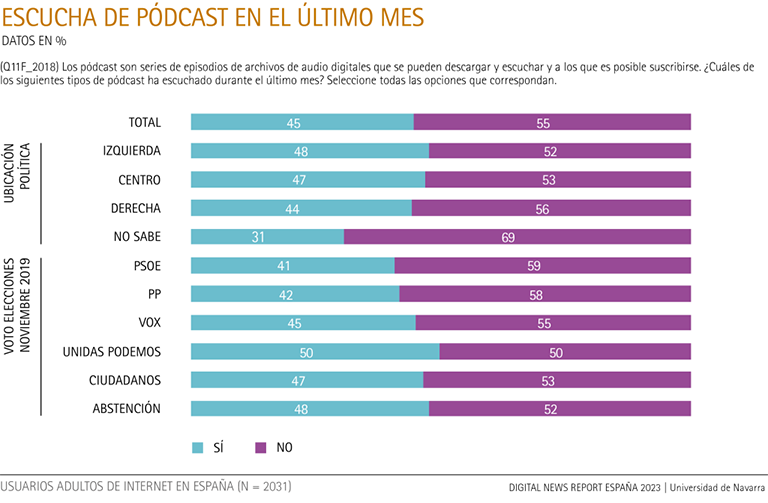
Differences according to ideological self-placement and vote recall in the November 2019 elections.
There are no significant differences in podcast listening according to the variable on the ideological self-placement of the respondents: the percentages of listening among those on the left (48%) and center (47%) are slightly above the average listening (45%) and those on the right (44%). However, there is a significant difference with respect to those who choose not to answer (don't know/no answer), since 31% say they listen to podcasts and, therefore, 69% do not listen to podcasts, a percentage similar to that of previous years.
As for the results according to the variable of vote recall in the November 2019 elections, the response options had to obtain a base greater than 100. The options that meet this condition are PSOE (n = 455), PP (n = 343), Vox (n = 244), Unidas Podemos (n = 209), Ciudadanos (n = 112) and abstention (n = 424).
The highest proportion of podcast listeners is found among those who voted for Unidas Podemos (50%) and among those who abstained (48%). The percentages of these options are significantly higher than the proportion of podcast listeners who voted for the PSOE (41%). Among the other parties, 47% of Ciudadanos voters, 45% of Vox voters and 42% of PP voters reported listening to podcasts.
Likewise, there is a significant difference in those who say they do not listen to podcasts among PSOE voters (59%) compared to 50% of Podemos voters and 52% of those who abstained.

Specialized and lifestyle topics remain the most listened-to podcast topics.
Spanish Internet users continue to prefer podcasts on specialized topics (e.g., science and technology, Economics and business, media, health, history) (18%) and lifestyle (e.g., food, fashion, art, literature, travel, entertainment) (16%). 14% of Internet users listen to current affairs podcasts (news, politics and international events) and 14% to social issues and events (e.g. crime, human stories). Sports podcasts remain with an audience of 8%.
Considering that podcast consumption is higher among men (51%) than among women (38%), there is a significant difference in the consumption of podcasts on specialized topics (22% of men compared to 14% of women), current affairs (18% of men compared to 10% of women) and sports (13% of men compared to 4% of women). Men also listen to more podcasts about social issues and events (e.g., crime, human stories) (16%) than women (13%). Women, on the other hand, pay more attention to lifestyle-themed podcasts (18%, compared to 15% of men).
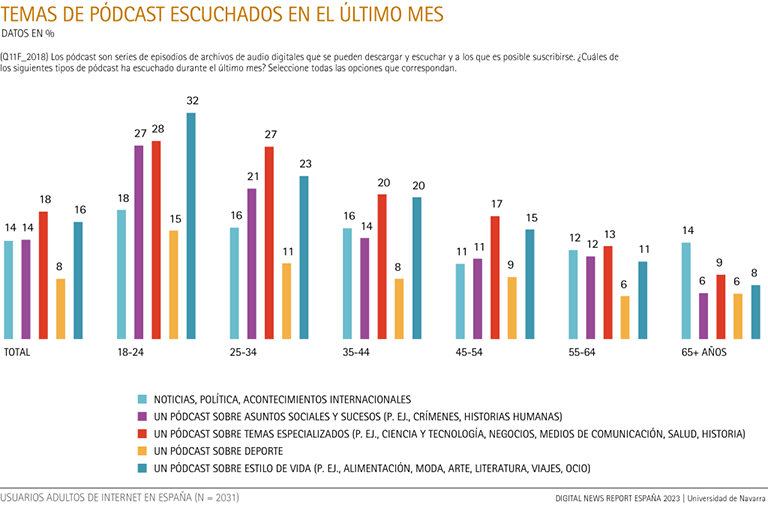
The interest of the youngest (18 to 24) in podcasts is evident in each of the thematic categories considered in the survey, in which they obtain higher percentages with respect to the other age groups.
News podcasts are of greater interest to Internet users up to the age of 44 (16%) than to those over 45 (12%). The 18-34 year-old audience for productions on social issues and events (23%) is more than double that of the over-35s (11%). Similarly, podcasts on specialized topics attract almost three out of ten Internet users aged 18 to 34 (27%), compared with 15% of those aged 35 and older. Fifteen percent of Internet users aged 18 to 24 consume sports podcasts, more than twice as many as those aged 35 and over (7%). Finally, the percentage of lifestyle podcast listeners among 18-24 year olds (32%) is double the average (16%). This topic also attracts two out of three Internet users aged 25 to 34 (23%) and 35 to 44 (20%).
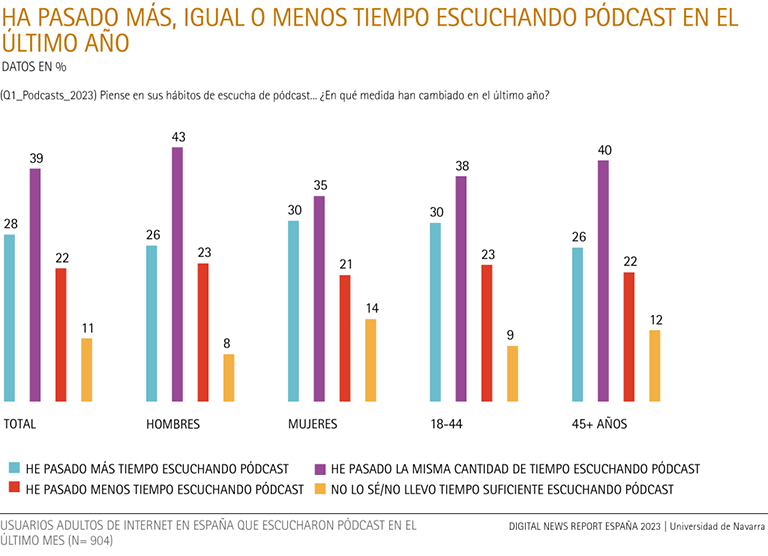
Three out of ten users spend more time listening to podcasts
Given the upward trend in podcast consumption, this year, survey has included a new question about the amount of time Username has spent listening.
Thus, the podcast continues to attract the attention of the majority of users: three out of ten podcast listeners (28%) say they have spent more time listening to podcasts in the last year, and four out of ten (39%) say they have spent the same amount of time. Meanwhile, two in ten (22%) say they have spent less time and 11% say they do not know or have not spent enough time listening to podcasts.
Among women, 30% say they have spent more time, compared to 26% of men. By age, more among adult users up to 44 years of age (30%) than among those over 45 (26%).
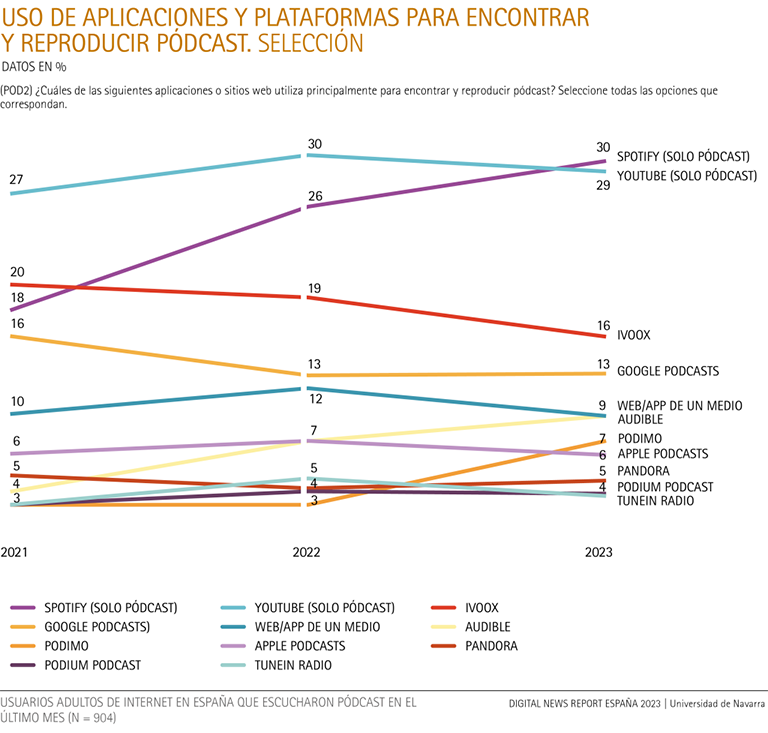
Spotify, YouTube and iVoox top the list of platforms for finding and playing podcasts
Spotify (30%), YouTube (29%) and iVoox (16%) are the most used to find and play podcasts for Spanish Internet users who listen to podcasts (n = 904), followed by Google Podcasts (13%).
Podcast listening on Spotify has grown twelve percentage points since 2021 (four in the last year), while search or listening to podcasts via YouTube is down one point in 2023. In contrast, iVoox listening follows a downward trend, from 20% in 2021 to 16% in 2023. Google Podcasts repeats the same percentage (13%) this year.
The other platforms are below 10%. Between 2021 and 2023, the growth of Audible (from 4% to 9%) and Podimo (from 3% to 7%) stands out, while Apple Podcasts (6%), Pandora (5%), Podium Podcast (4%) and TuneIn Radio (4%) maintain their respective percentages. However, podcast consumption via web and media app has dropped three points in the last year, from 12% to 9%, one percentage point below the 2021 record (10%).
The following table shows the percentages of podcast users on all the platforms considered in the 2023 survey , according to the variables of gender (male and female) and age (18 to 44 years old, and 45 years old and older).
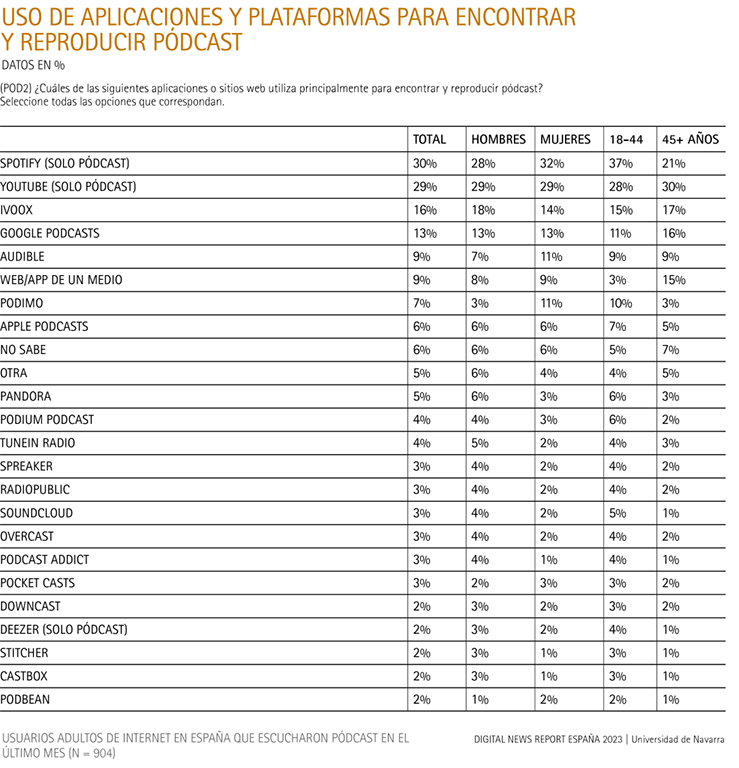
More women than men at Spotify, Audible and Podimo
By gender, Spotify is more popular among women (32%) than men (28%). Nearly half (47%) of female podcast listeners aged 18-34 use Spotify, compared to four in ten (37%) male podcast listeners in the same age group ( group ).
Audible (11% vs. 7%) and Podimo (11% vs. 3%, the difference is significant in this case) are also more widely used among women. Especially among women aged 18 to 44, two out of ten (18%) use Podimo.
On the other hand, there is a higher proportion of men among iVoox users (18% vs. 14%) and on most of the other platforms, as can be seen in the table.
Four out of ten internet users up to 44 years old listen to podcasts on Spotify
Spotify is the most used platform among internet users up to 44 years of age. Four in ten users aged 18 to 44 (37%; 41% among those under 35) use Spotify to find and play podcasts, compared to two in ten (21%) for those aged 45 and over. For the latter, Spotify is the second most used platform, behind YouTube (30%).
YouTube is the number one platform for Internet users aged 45 and over (30%), and the second in the 18-44 age group (28%), although the percentage is slightly higher for 18-34 year olds (31%).
iVoox users are predominantly aged 35 and over (18%), compared to 12% of young people up to 34.
Google Podcasts is also a platform with more users aged 55 and older (20%), while among young people aged 18 to 34, they are barely one in ten (9%).
Other differences in podcast consumption by age are highlighted in media websites and apps, where there are hardly any users among young people between 18 and 34 (1%), compared to 12% from 35 years of age onwards, and consumption is significantly higher from 55 years of age onwards, with 20%.
Podimo's audience is also characterized by a significantly higher percentage of users among young people (11% for group 18 to 34) and up to 44 years of age (10%), compared to 3% of users aged 45 and over.
Finally, the significant difference in Podium Podcast podcast consumption among Internet users up to 44 years of age (6%), compared to 2% for those aged 45 and older, was highlighted.
According to the income level variable, there is a significant difference in the use of Apple Podcasts for high-income users (10%) compared to those with an income of average (4%). The difference is also significant for iVoox users of average (18%) and high income (17%) compared to those of leave (10%).
Similarly, significant differences are found according to the level of Education by Apple Podcasts users with a high level (10%), compared to those with a medium level (4%) and low level (3%). The percentage of Google Podcasts users with a medium level of Education (18%) is also significantly higher than those with a high level (10%). Similarly, four out of ten high-level Education users (37%) use Spotify to search for and find podcasts, compared to 25% of medium programs of study users and 24% of low level users.
According to the ideological location of users, there is a significant use of Apple Podcasts to listen to podcasts by users who declare themselves to be of the center (8%), compared to those on the left (3%); also for Google Podcasts users on the right (18%) compared to 10% on the left; and finally, on iVoox, for two out of ten users on the left (20%), compared to one out of ten (13%) in the center.